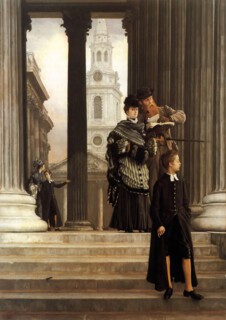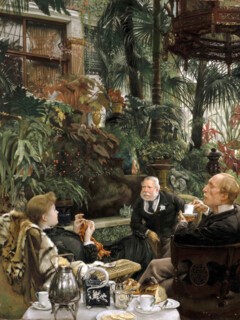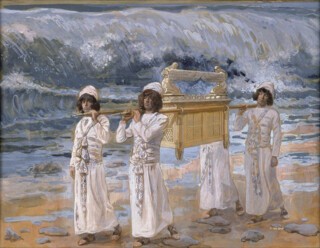In Martin Scorsese ’s film adaptation of The Age of Innocence, facsimiles of James Tissot’s paintings hang on the walls of the Beauforts’ Gilded Age mansion, the setting for the annual Opera Ball, where New York plutocrats dance with women in Tissot-inspired dresses. An oversized replica of Too Early (1873) shows the sniggering that meets a group of early arrivals at a ball. Across from it hangs The Concert (Hush!), painted the following year, in which guests crowd a drawing room as a violinist raises her instrument to play. They gossip, stare and slump in their chairs looking bored, just like the extras milling about in front of the picture. When the narrator tells us that this is ‘a world balanced so precariously that its harmony could be shattered by a whisper’, the camera zooms in on another ballroom painting, The Political Woman (c.1883-85). The woman’s serene face is a warning that ambitious people can destroy lives with their whispers, but we get the sense from the crowd chattering around her that she is going to be destroyed too.
The Political Woman was part of a series of 15 paintings of Parisian women that Tissot made on his return to the city after almost a decade in London. Shop girls, circus performers, fashion mavens, artists’ wives, even a female artist and a worn-out art lover in the Louvre announced his return to the painting of modern Parisian life. But French critics kept insisting that the women were English, and British and American collectors were more eager to buy. He was seen by his contemporaries as neither fully French nor legitimately English, but an odd mixture of the two. Americans would end up being his biggest fans. Tissot cultivated the ambiguity about his identity, which contributed to his international success, but also bred suspicion and resentment.
The suspicion and resentment have endured. The contemptuous greeting the metropolitan hosts give their awkward provincial guests in Too Early mirrors the reception of Tissot’s paintings over the past 150 years. Critics and scholars tend to dismiss his work as garish and excessive. The French painter and socialite Jacques-Émile Blanche said that Tissot’s pictures were ‘ill-judged for complex reasons’, but some of the reasons are not so complex. ‘More is more’ was his guiding principle. In 1873 an English critic wrote that he had ‘fairly out-Tissoted himself’ with Too Early, and found a ‘truthfulness’ and humour in the situation comparable to the novels of Jane Austen. Tissot had an eye for social comedy and an ability to distil a narrative. But he also had a tendency to overdo things: too much detail, too much precision, too many flounces, a conceit taken too far, straining towards literature. He was too slick, too easy with his talent, and was posthumously demoted to second-tier status by the modernist criteria of difficulty and self-critique.
This ambitious catalogue to an exhibition curated by Melissa Buron of the Fine Arts Museums of San Francisco, brings fresh eyes and careful research to his work. James Tissot: Fashion and Faith, opened at the Legion of Honour Museum in San Francisco last October and has just reopened – three months late – as James Tissot: l’ambigu moderne at the Musée d’Orsay, with a run extended until September. For those unable to see it, the book serves as considerably more than a standard exhibition catalogue, and includes a reproduction of Tissot’s sales notebook, recently discovered at his former estate, the Château de Buillon, as well as previously unpublished personal photographs. The authors survey the impressive range of Tissot’s production, from paintings and etchings to book illustrations and cloisonné enamels, and subjects from medieval costume pieces to portraiture and modern leisure. The survey concludes with an examination of his biblical watercolours, which inspired scenes in many 20th-century films.
Born in Nantes in 1836 as Jacques-Joseph Tissot, he had begun calling himself James by 1859, when he first exhibited at the Paris Salon. Five of his paintings were accepted, including a portrait of his mother and two pictures of saints. His father, a successful draper, and mother, a hat designer, were devout Catholics and Tissot spent part of his adolescence at a Jesuit boarding school in Belgium where he mixed with English students: his lifelong Anglophilia may have begun there. In Paris he found success and social connections. He was trained by former students of Ingres along with Degas, who became a close friend, and met Whistler while copying an Ingres at the Musée du Luxembourg. Portraits of high society and genre scenes of fashionable women fuelled his rise in the 1860s, and by 1866 he had made enough money to build an impressive home on the avenue de l’Impératrice (now avenue Foch) in the 16th arrondissement, which he filled with one of the earliest European collections of Japanese art.
He managed his career skilfully. Degas was jealous, and asked him for tips, while Sargent called him ‘almost a dealer – of genius’. Krystyna Matyjaszkiewicz describes his early strategy of quoting clients eye-popping sums – a small fraction of which he hoped to receive – to make his paintings seem aspirationally expensive. Buyers could feel triumphant after talking him down. Tissot understood that his home and studio were spaces of artistic and social performance. He exhibited paintings there to invited guests, and no flourish of décor or hospitality was too much.
He served as a sharpshooter in the Franco-Prussian War and sketched the body of a fallen friend with a cool focus that disgusted Degas, who felt he should have retrieved the body rather than drawing it. A watercolour of a wounded soldier in uniform sitting on a pile of smart clothes in an elegant interior shows his worlds colliding, an attempt to reconcile the brutality of war with the upscale beauty on which his career was founded. His head and shoulders framed by gilded lines of decorative moulding, the soldier looks up at the viewer through heavy-lidded eyes, his arm in a sling. He is a rare example of a sexually inviting male figure in Tissot’s work. Degas probably hated this, too.
Bertrand Tillier writes that Tissot participated in the Paris Commune after the French defeat, driving an ambulance as part of the insurgent branch of the National Guard. His support appears to have been heartfelt – which seems strange considering how much he had benefited from the Parisian elite – but it didn’t last. He left Paris for London as soon as the Commune was crushed, writing letters to the French police and Ministry of War to clear his name. They had no file on him, but the rumours were damaging enough, and in 1876 one of the Commune’s historians, Prosper-Olivier Lissagaray, named him in print. After this, Tissot’s politics, like those of his Political Woman, became strictly social.
Degas tried to lure Tissot back to Paris to participate in the first Impressionist exhibition, but he showed no interest in circumventing the system that had served him so well. Nor did he respond to appeals to patriotism. ‘Be of your country and with your friends,’ Degas wrote, but Tissot refused. He liked being French in London, where his dealers helped him market Frenchness to the world. He re-created the Parisian settings for his paintings at his home in St John’s Wood, where he had a large studio, a conservatory and a formal garden with ornamental pool, framed by an ironwork replica of the stone colonnade in Parc Monceau, the setting for Quarrelling (1875-76), The Convalescent (1875) and Holyday (1876). Edmond de Goncourt wrote that Tissot kept champagne on ice outside his studio for visitors and employed a footman in silk stockings to shine the leaves in the shrubbery. Whether accurate gossip or simply one of Goncourt’s imaginative barbs, it captures the excessive polish and materialism of Tissot’s style – a waxy sheen, saturation of colour and sharpness that can be particularly jarring in his garden scenes.
Peter Trippi notes the British ambivalence towards Tissot, and towards foreign (especially French) cultural influence in general. English critics admired his draughtsmanship, calling him ‘the French Millais’, but disapproved of his subjects: the Spectator referred to them as ‘ladies in hammocks’. His dexterity and ‘vulgar’ comedy reminded some of Trollope, a comparison that was at best a backhanded compliment. Others called him ‘a kind of artistic Zola’, which was intended as an outright insult. But they agreed his talent was undeniable, full of ‘amazing truth and observation’. Before arriving in London, Tissot had published caricatures of European royalty in Vanity Fair. The editor introduced him to London society. He joined the Arts Club and adapted his work to English tastes, painting pictures with narrative clues and chapter-like titles (The Captain’s Daughter, The Last Evening). A critic for the Academy accused him of taking ‘a rather perverse pleasure’ in showing off his skill.
London Visitors (1874), exhibited at his studio and at the Royal Academy the year it was made, may be a coded response. A smartly dressed couple stand on the steps of the National Gallery, holding a guidebook and planning the rest of their day. The clock visible through the portico reads half past ten, a clue that they have moved quickly through the galleries. The neoclassical architecture and limited palette give the scene an uncharacteristic austerity – the young guides’ mustard-yellow stockings are the only spots of colour – but the woman’s dress is too elaborate for museum-going and a cigar on the steps pointed in her direction signals a male presence beyond the frame. Ignoring her husband, she makes eyes at this other man as she points her umbrella towards Trafalgar Square.
Perhaps Tissot was imagining himself through the eyes of his Victorian critics as a fashionable woman, lacking the moral fibre and intellect to appreciate great art. Seen this way, it’s hard not to enjoy London Visitors as a parody of the London art world’s thinly veiled contempt for Tissot – an outsider with money to burn – and for the ambitious women he loved to paint. The degree to which this woman cares about her critics is written on her face. Tissot’s career suggests that he, too, couldn’t care less.
Tissot made so much money in London that he was soon as wealthy as the peers he was commissioned to paint. British artists resented him and by 1880 they had closed ranks, shutting him out of exhibition opportunities in London. He mounted a one-man show at the Dudley Gallery, which included paintings and a group of cloisonné enamel sculptures and vases that showed his ability to master the most difficult and painstaking techniques. It was almost completely ignored by the metropolitan press. One of his more sympathetic critics in the Illustrated London News admitted his work had a ‘Gallic sneer’, but defended his talent: ‘Nothing is more curious than the personal antipathy which most people of taste express for this very skilful artist. Standing before his picture called The Rivals, it is possible to understand this aversion, but scarcely to excuse it.’ The Rivals (1878-79) depicts two older men flirting with a beautiful woman, who lounges on a tiger skin in Tissot’s conservatory. The older gentleman leaning toward the woman is mocked by a piece of garden statuary on the ledge beside him: a plump stone rabbit that looks ready to pounce. Tissot treats every square inch of the painting as an opportunity to parade his virtuosity and wealth (it is possible to understand the aversion to this picture), ranging deftly over animal fur, a sparkling tea service with a Japanesque Royal Worcester pot, gilded pilasters and lattice ironwork grilles, a large Japanese birdcage hanging from the ceiling and a profusion of botanical trophies. Holding court is Tissot’s favourite model, the Irish divorcée Kathleen Newton.
Newton and Tissot lived together in St John’s Wood from 1876 until her death from tuberculosis in 1882. He left for Paris the day after she was buried and put their house up for sale a few months later. His paintings of Parisian women were an effort to re-establish his reputation in France, but they were panned in the press. The French market for his work had cooled. He became interested in spiritualism and attended séances, hoping to see Newton appear. On one occasion he claimed she did, a vision recorded in The Apparition (1885). Around the same time, he said he had seen Christ in the church of Saint-Sulpice, an experience that led him to spend the rest of his life painting scenes from the Bible. Buron argues that Tissot’s visions and religious artworks were sincere, but she also acknowledges they were well timed, attuned to popular fascination with the occult and the French Catholic revival.
Two extended trips to the Holy Land in 1886-87 and 1888-89 generated hundreds of opaque watercolours of New Testament scenes, exhibited to reverent crowds in London and Paris in the mid-1890s. Small in scale but full of detail and expressive gesture, they demonstrate Tissot’s storytelling flair, as well as his enterprising spirit. In 1898 he sent them on a tour of the US and Canada, which turned him into an international sensation. There were plans for a Tissot Museum at the Exposition Universelle in Paris in 1900, but the Brooklyn Museum bought all of the New Testament watercolours by public subscription a few months before its opening. Tissot died in 1902, leaving a corresponding set of Old Testament scenes unfinished; the American Tissot Society organised a tour for them anyway. They are now in the Jewish Museum in New York, where they have been seen by generations of filmmakers. Moses and Joshua in the Tabernacle and The Ark Passes Over the Jordan (c.1896-1902) are clearly the source for Steven Spielberg’s Ark of the Covenant in Raiders of the Lost Ark. In The Last Temptation of Christ, Scorsese draws from several of Tissot’s crowded biblical scenes, just as D.W. Griffith (Intolerance) and Cecil B. DeMille (The King of Kings) did before him. The impact of these paintings on the history of cinema is hard to overstate. Valentine Robert calls them ‘protocinematic’ in their continuous temporal flow and shifting points of view; her catalogue essay traces the many filmmakers who have used their almost documentary detail like a storyboard. Besides the Americans, these include Alice Guy-Blaché (La Vie du Christ), Sidney Olcott (From the Manger to the Cross) and Franco Zeffirelli (Jesus of Nazareth).
Despite, or perhaps because of, his huge commercial success and influence on film, Tissot’s posthumous reputation has suffered, especially in France. Reporting from the sale of the contents of his château in 1964, a French journalist teased: ‘One feels that James Tissot had brought back from his long stay in England a taste [for] ghosts haunting the romantic castles.’ But Tissot’s castle, a medieval abbey near Besançon, was very French. The jibe is another example of French and English writers using Tissot to take shots at each other. For the French, he was too English. For the English, he was too ‘vulgar’, which was just another way of saying he was too French. Neither liked his determination not to pick a side.
Tissot scholars still find themselves defending him against charges of empty virtuosity. While his art is more complex – psychologically, sociologically – than many of his detractors allow, the complexity is in the virtuosity, the opportunism, and his sense of humour about both. His chief contribution may be his unsparing description of the decadence of the Belle Époque, and like J.K. Huysmans, who followed À rebours (1884) with a return to the Catholic Church, his career shows how quickly decadence can turn into religion. Tissot’s painting of modern life is more fun to look at, not to mention more instructive, if you accept its perversity and admit that there is something perverse in your attraction to it. He was drawn to the most extravagant aspects of late 19th-century metropolitan life – fashion, social ambition, conspicuous wealth, the obsession with Oriental objets – and depicted them uncritically. This is hard for many to stomach, especially right now, but he also laughed at this world and showed its absurdities. In seven of his pictures a pug is shown as the accessory of a fashionable lady. A dog bred to have an appearance that limits its ability to breathe, itʼs an apt mascot for the social sphere Tissot depicted in his work.
Send Letters To:
The Editor
London Review of Books,
28 Little Russell Street
London, WC1A 2HN
letters@lrb.co.uk
Please include name, address, and a telephone number.




